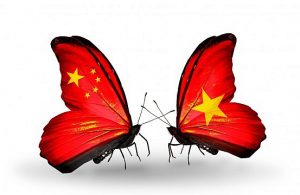China is situated in Eastern Asia on the Western shore of the Pacific Ocean and encompasses an area of 9.6 million square kilometers. China’s continental coastline extends along 18,000 kilometers, and its vast sea surface is studded with more than 5,000 islands. More than 1.2 billion people live in China.
Thanks to its reform and opening-up policy, China has become stronger and stronger in economy, science and technology. The nation’s economy has been growing rapidly, with the GDP dramatically increasing year by year. President Xi Jinping closing remark of the meanwhile famous speech at this years’ Davos WEF summit is leading the way: “We Chinese know only too well what it takes to achieve prosperity so we applaud the achievements of others and we wish them a better future. We are not jealous of others’ success and we will not complain about the others who have benefited. We will welcome them aboard the express train of Chinese development.” China’s economy is gradually shifting from a merely production-oriented to an innovation-led economy. Thus the Chinese markets will continue to open up and Chinese companies will internationalize as Western companies will explore China as a future market and supply source to an even greater extent.
Vietnam is the easternmost country on the Indochina Peninsula in Southeast Asia. With an estimated 90.5 million inhabitants as of 2014. Vietnam is bordered by China to the north. Its capital city has been Hanoi since the reunification of North and South Vietnam in 1975.
Vietnam was part of Imperial China for over a millennium, from 111 BC to AD 939. An independent Vietnamese state was formed in 939.The nation expanded geographically and politically into Southeast Asia, until the Indochina Peninsula was colonized by the French in the mid-19th century. Following a Japanese occupation in the 1940s, the Vietnamese fought French rule in the First Indochina War, eventually expelling the French in 1954. Thereafter, Vietnam was divided politically into two rival states, North and South Vietnam. Conflict between the two sides intensified in what is known as the Vietnam War. The war ended with a North Vietnamese victory in 1975.
Vietnam was then unified under a communist government but remained impoverished and politically isolated. In 1986, the government initiated a series of economic and political reforms which began Vietnam’s path towards integration into the world economy. By 2000, it had established diplomatic relations with all nations. Since 2000, Vietnam’s economic growth rate has been among the highest in the world. Its successful economic reforms resulted in its joining the World Trade Organization in 2007.
Twenty-five students in their final semester at the ZHAW School of Management and Law (SML) embark on this study trip to China and Vietnam following attendance of the seminar “Doing business in Emerging Markets”. The objectives of this study trip are:
- Experience the Chinese and Vietnamese way of life through real on-site exploration
- Explore the cultural heritage and learn how to integrate the findings into doing business in emerging markets
- Understand the buying power of China and Vietnam and its neighboring countries
- Learn the first steps to expand one’s individual business network beyond Switzerland
- Expand the horizon for a future professional career.
My heartfelt thanks goes to all organizations, companies and business partners in China and Vietnam who generously invited our SML student group. We deeply appreciate their support.
Moreover, I would like to thank the entire student group who co-organized this trip and in particular the core organizing team Beatrice Phua (CEO), Christian Spring (COO), Andrea Cavegn (CFO) and Andrin Wilhelm (CTO). We are all looking forward to this no doubt extremely rewarding and memorable journey.
Best wishes
Dr. Markus Braun
ZHAW School of Management and Law / Zurich University of Applied Sciences
